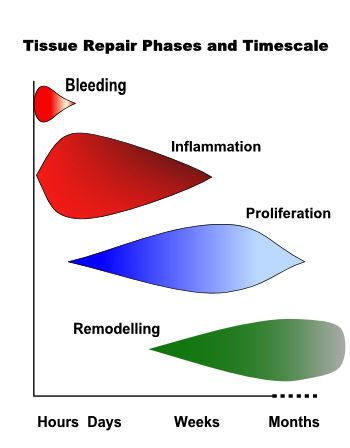
Have you experienced a nagging injury that doesn’t seem to go away? Well you’re not alone. Clients often come to physiotherapy because of lingering injuries. Usually these clients are frustrated because they expected their injury to have healed already.
Today I am going to show you how long some injuries can take to heal, and why. This will help guide your recovery process, and provide you with some expectations for your specific timeline.
Soft Tissue Repair
The type of tissue damaged plays a key role in the healing process. Bone injuries will heal differently than soft tissue (all the things in your body that aren’t bone). Let’s take a look at soft tissue repair first.
Phase One
The first phase of a soft tissue injury is bleeding. This might be external bleeding, where you can actually see blood, or internal bleeding where you might see some bruising or discoloration.
In some injuries there may be small amounts of bleeding that aren’t even visible.
After an injury, the body’s immediate response is to stop the bleeding. Within 24 hours, inflammation occurs around the injury site, and the body forms a blood clot. This blood clot not only stops bleeding, but also forms a basis for tissue healing to take place.
During inflammation, the blood vessels around the injury increase in size, so that special cells can travel to the injury site to break down damaged tissue and kill bacteria. As shown in the image above, inflammation can last from days to weeks, but usually completes after 1 week.
Phase Two
While inflammation is happening at the injury site, the second phase of healing, called proliferation, starts. During this phase, new tissue (granulation tissue) is laid down that contains new blood vessels. However, this tissue and its blood vessels are initially weak. As the blood vessels grow stronger, more tissue (collagen) is laid down on top of the granulation tissue.
As more tissue is laid down, a scar eventually starts to form which fills in the gap left from the injury. The scar also restores the strength and integrity of the injured tissue. As you can see above, proliferation starts during inflammation within hours after injury, but can last for months afterwards.
Phase Three
The final phase of soft tissue healing is called remodelling. During this phase your body works to improve the strength and integrity of the newly formed scar. At first, a newly formed scar is weak compared to uninjured tissue. As stress is placed on the scar through movement, more tissue is laid down that is aligned in a better position. This increase in scar tissue with better alignment improves its strength, making it more similar to uninjured soft tissue. In the remodeling phase, the body also works to decrease the borders of your wound. This means your scar will decrease in size over time. Remodeling can occur over weeks, months, or even years depending on the injury.
While bone healing is similar to soft tissue healing, there are also some important differences. As shown in the image above, the stages of bone healing after a fracture (a break in the bone) consist of hematoma formation, fibrocartilaginous callus formation, bony callus formation, and bone remodelling. Here is a brief introduction to each:
Hematoma formation
Right after a bone is injured, a hematoma forms. This means blood will rush in and fill the space where the bone was damaged. After an injury to the bone, inflammation causes the hematoma to coagulate, which means all of the blood filling in the space of damaged bone will clot. This blood clot will form the basis of new bone formation. As inflammation persists, new blood vessels are formed around the injury site.
Fibrocartilaginous callus formation
After a hematoma is formed at the injury site, new tissue starts to form there called granulation tissue. This tissue turns into a soft callus made of cartilage, which bridges the gap of the fracture site and provides stability. This soft callus starts to form around the first week after fracture, and continues for around three weeks.
Bony callus formation
Once a soft cartilage callus is fully formed within the fracture site, it needs to be turned into a hard callus before new bone can be created. In order to do this, the cells that create the soft cartilage callus grow and calcify (meaning they become more firm and rigid). As the bony callus formation progresses, this calcified cartilage is replaced with bone. The formation of a hard callus starts around three weeks after injury, and continues for about three months.
Bone remodeling
When bone is initially created within the fracture site, it is formed as woven bone. Woven bone is mechanically weak because the tissue fibers within it are not organized well. In order to restore the normal structural properties of bone, this woven bone must be remodelled into lamellar bone (normal bone). This process is completed by your body breaking down the woven bone, while also depositing new lamellar bone. The new lamellar bone has better alignment of its tissue fibers, which makes it much stronger than the woven bone. Putting weight or stress through the bone is important to help align the tissue fibers. While this process begins around three to four weeks, it may take years to completely regenerate normal bone structure.
If you want to see a cool visual representation of bone remodeling after a broken hand, check out this case study we did on a former CFL offensive lineman.
How does physiotherapy improve recovery time for injuries?
Physiotherapy has been shown to speed up recovery time for injuries through early mobilization. For example, if there were two people who both had ankle sprains, and one chose to attend physiotherapy while the other chose to rest their injury, the person attending physiotherapy would recover faster. This is because physiotherapy will improve the motion, strength, stability, and function of the ankle, while complete rest will not.
What role does physiotherapy play in tissue healing?
Physiotherapy plays an important role in tissue healing. It has been shown to stimulate healing, as well as help to control pain, swelling, and inflammation. Plus, physiotherapy helps prevent other complications that can occur after an injury, such as muscle wasting. When we injure a body part, we often rest it until it feels better. However, too much rest is actually counterproductive, as it can lead to loss of muscle size and strength around the injury. In order to have the best healing possible, it is important to have a good balance of rest and exercise. A physiotherapist can help you figure out what that balance looks like for you and your injury.
When during the healing process can I begin physiotherapy?
You can begin physiotherapy at any point during the healing process. Starting physiotherapy as soon as possible is ideal because it can help you manage your injury appropriately from start to finish. While it is best to start physiotherapy early on after an injury, it is still effective with longstanding injuries. Physiotherapy treatment will be different at each stage of healing, and individualized to meet your needs.
Why isn’t my injury healed even though enough time has passed?
It’s important to remember that the information presented here is a general guideline for injury healing. This timeline may be altered by many individual factors, such as age, sleep, diet, size or severity of the injury, and more.
Plus, you may still experience pain even though an injury has healed. Sounds crazy, right? We have dedicated multiple posts on pain alone, and you can check them out here.
Still not sure what to expect with your injury? Call us at 519-895-2020, or use our online booking tool on www.strivept.ca to book an appointment with one of our knowledgeable physiotherapists, and they will be sure to help you understand your injury.
Cheers,
Liam Newlands
Physiotherapist at Strive Physiotherapy and Performance

